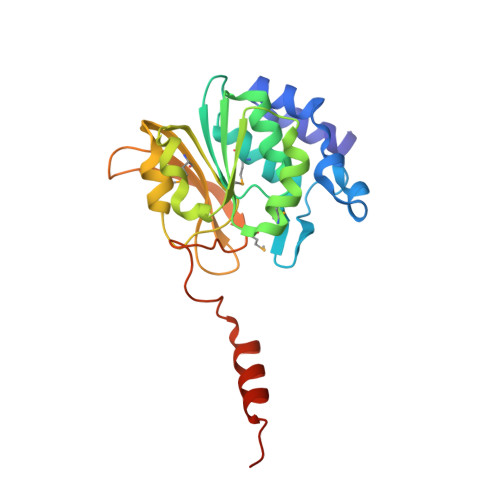How Oligomerization Contributes to the Thermostability of an Archaeon Protein: PROTEIN L-ISOASPARTYL-O-METHYLTRANSFERASE FROM SULFOLOBUS TOKODAII
Tanaka, Y., Tsumoto, K., Yasutake, Y., Umetsu, M., Yao, M., Fukada, H., Tanaka, I., Kumagai, I.(2004) J Biological Chem 279: 32957-32967
- PubMed: 15169774
- DOI: https://doi.org/10.1074/jbc.M404405200
- Primary Citation of Related Structures:
1VBF - PubMed Abstract:
To study how oligomerization may contribute to the thermostability of archaeon proteins, we focused on a hexameric protein, protein L-isoaspartyl-O-methyltransferase from Sulfolobus tokodaii (StoPIMT). The crystal structure shows that StoPIMT has a distinctive hexameric structure composed of monomers consisting of two domains: an S-adenosylmethionine-dependent methyltransferase fold domain and a C-terminal alpha-helical domain. The hexameric structure includes three interfacial contact regions: major, minor, and coiled-coil. Several C-terminal deletion mutants were constructed and characterized. The hexameric structure and thermostability were retained when the C-terminal alpha-helical domain (Tyr(206)-Thr(231)) was deleted, suggesting that oligomerization via coiled-coil association using the C-terminal alpha-helical domains did not contribute critically to hexamerization or to the increased thermostability of the protein. Deletion of three additional residues located in the major contact region, Tyr(203)-Asp(204)-Asp(205), led to a significant decrease in hexamer stability and chemico/thermostability. Although replacement of Thr(146) and Asp(204), which form two hydrogen bonds in the interface in the major contact region, with Ala did not affect hexamer formation, these mutations led to a significant decrease in thermostability, suggesting that two residues in the major contact region make significant contributions to the increase in stability of the protein via hexamerization. These results suggest that cooperative hexamerization occurs via interactions of "hot spot" residues and that a couple of interfacial hot spot residues are responsible for enhancing thermostability via oligomerization.
- Department of Biomolecular Engineering, Graduate School of Engineering, Tohoku University, Aoba-yama 07, Aoba-ku, Sendai 980-8579, Japan.
Organizational Affiliation:

















